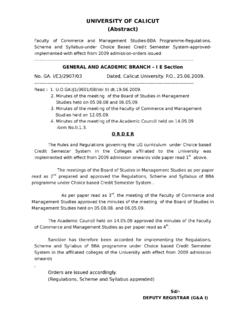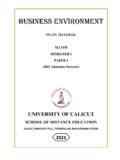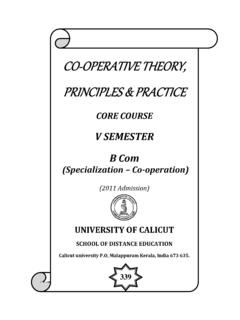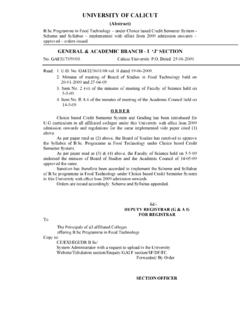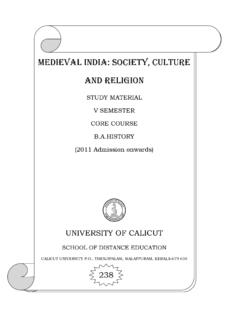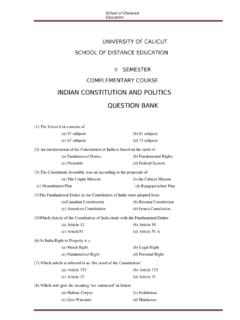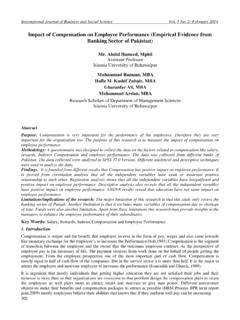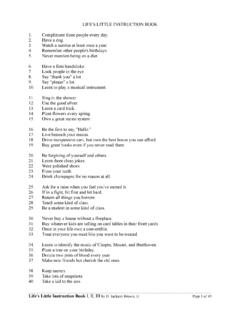Transcription of QUANTITATI VE TECHNIQUES FOR B USINESS - …
1 QQUANUNCaNTITF COMBBNIVESCHO alicut UniveTATIFOR BMPLEMBBA (IB Com((201 ERSITOOL OF Dersity IVE BUSIMENTAIII Sem(IV Sem1 AdmiTY ODISTANC Malappura 412 TECSINESARY COmestemesteission) OF CACE EDUCam, Kerala2 CHNISS OURSEr) er) ALICUCATION a, India 673 IQUEE UT 3 635 ES School of Distance Education quantitative TECHNIQUES for business 2 UNIVERSITY OF CALICUT SCHOOL OF DISTANCE EDUCATION STUDY MATERIAL Complementary Course for BBA (III Semester) B Com (IV Semester) quantitative TECHNIQUES FOR business Prepared by Sri. VineethanT,Assistant Professor, Department of Commerce, Govt. College, Madappally. Scrutinized by Dr. K. Venugopalan, Associate Professor, Department of Commerce, Govt. College, Madappally. Layout: Computer Section, SDE Reserved School of Distance Education quantitative TECHNIQUES for business 3 CONTENTS CHAPTER NO.)
2 TITLE PAGE NO. 1 quantitative TECHNIQUES 5 2 CORRELATION ANALYSIS 11 3 REGRESSION ANALYSIS 34 4 THEORY OF PROBABILITY 49 5 PROBABILITY DISTRIBUTION 72 6 BINOMIAL DISTRIBUTION 75 7 POISSON DISTRIBUTION 83 8 NORMAL DISTRIBUTION 87 9 TESTING OF HYPOTHESIS 94 10 NON-PARAMETRIC TESTS 117 11 ANALYSIS OF VARIANCE 131 School of Distance Education quantitative TECHNIQUES for business 4 School of Distance Education quantitative TECHNIQUES for business 5 CHAPTER 1 quantitative TECHNIQUES Meaning and Definition: quantitative TECHNIQUES may be defined as those TECHNIQUES which provide the decision makes a systematic and powerful means of analysis, based on quantitative data. It is a scientific method employed for problem solving and decision making by the management. With the help of quantitative TECHNIQUES , the decision maker is able to explore policies for attaining the predetermined objectives.
3 In short, quantitative TECHNIQUES are inevitable in decision -making process. Classification of quantitative TECHNIQUES : There are different types of quantitative TECHNIQUES . We can classify them into three categories. They are: 1. Mathematical quantitative TECHNIQUES 2. Statistical quantitative TECHNIQUES 3. Programming quantitative TECHNIQUES Mathematical quantitative Techcniques: A technique in which quantitative data are used along with the principles of mathematics is known as mathematical quantitative TECHNIQUES . Mathematical quantitative TECHNIQUES involve: 1. Permutations and Combinations: Permutation means arrangement of objects in a definite order. The number of arrangements depends upon the total number of objects and the number of objects taken at a time for arrangement.
4 The number of permutations or arrangements is calculated by using the following formula:- = n! n r ! Combination means selection or grouping objects without considering their order. The number of combinations is calculated by using the following formula:- = n! n r ! 2. Set Theory:- Set theory is a modern mathematical device which solves various types of critical problems. School of Distance Education quantitative TECHNIQUES for business 6 3. Matrix Algebra: Matrix is an orderly arrangement of certain given numbers or symbols in rows and columns. It is a mathematical device of finding out the results of different types of algebraic operations on the basis of the relevant matrices. 4. Determinants: It is a powerful device developed over the matrix algebra.
5 This device is used for finding out values of different variables connected with a number of simultaneous equations. 5. Differentiation: It is a mathematical process of finding out changes in the dependent variable with reference to a small change in the independent variable. 6. Integration: Integration is the reverse process of differentiation. 7. Differential Equation: It is a mathematical equation which involves the differential coefficients of the dependent variables. Statistical quantitative TECHNIQUES : Statistical TECHNIQUES are those TECHNIQUES which are used in conducting the statistical enquiry concerning to certain Phenomenon. They include all the statistical methods beginning from the collection of data till interpretation of those collected data. Statistical TECHNIQUES involve: 1.
6 Collection of data: One of the important statistical methods is collection of data. There are different methods for collecting primary and secondary data. 2. Measures of Central tendency, dispersion, skewness and Kurtosis Measures of Central tendency is a method used for finding he average of a series while measures of dispersion used for finding out the variability in a series. Measures of Skewness measures asymmetry of a distribution while measures of Kurtosis measures the flatness of peakedness in a distribution. 3. Correlation and Regression Analysis: Correlation is used to study the degree of relationship among two or more variables. On the other hand, regression technique is used to estimate the value of one variable for a given value of another. School of Distance Education quantitative TECHNIQUES for business 7 4.
7 Index Numbers: Index numbers measure the fluctuations in various Phenomena like price, production etc over a period of time, They are described as economic barometres. 5. Time series Analysis: Analysis of time series helps us to know the effect of factors which are responsible for changes: 6. Interpolation and Extrapolation: Interpolation is the statistical technique of estimating under certain assumptions, the missing figures which may fall within the range of given figures. Extrapolation provides estimated figures outside the range of given data. 7. Statistical Quality Control Statistical quality control is used for ensuring the quality of items manufactured. The variations in quality because of assignable causes and chance causes can be known with the help of this tool.
8 Different control charts are used in controlling the quality of products. 8. Ratio Analysis: Ratio analysis is used for analyzing financial statements of any business or industrial concerns which help to take appropriate decisions. 9. Probability Theory: Theory of probability provides numerical values of the likely hood of the occurrence of events. 10. Testing of Hypothesis Testing of hypothesis is an important statistical tool to judge the reliability of inferences drawn on the basis of sample studies. Programming TECHNIQUES : Programming TECHNIQUES are also called operations research TECHNIQUES . Programming TECHNIQUES are model building TECHNIQUES used by decision makers in modern times. Programming TECHNIQUES involve: 1. Linear Programming: Linear programming technique is used in finding a solution for optimizing a given objective under certain constraints.
9 2. Queuing Theory: Queuing theory deals with mathematical study of queues. It aims at minimizing cost of both servicing and waiting. School of Distance Education quantitative TECHNIQUES for business 8 3. Game Theory: Game theory is used to determine the optimum strategy in a competitive situation. 4. decision Theory: This is concerned with making sound decisions under conditions of certainty, risk and uncertainty. 5. Inventory Theory: Inventory theory helps for optimizing the inventory levels. It focuses on minimizing cost associated with holding of inventories. 6. Net work programming: It is a technique of planning, scheduling, controlling, monitoring and co-ordinating large and complex projects comprising of a number of activities and events. It serves as an instrument in resource allocation and adjustment of time and cost up to the optimum level.
10 It includes CPM, PERT etc. 7. Simulation: It is a technique of testing a model which resembles a real life situations 8. Replacement Theory: It is concerned with the problems of replacement of machines, etc due to their deteriorating efficiency or breakdown. It helps to determine the most economic replacement policy. 9. Non Linear Programming: It is a programming technique which involves finding an optimum solution to a problem in which some or all variables are non-linear. 10. Sequencing: Sequencing tool is used to determine a sequence in which given jobs should be performed by minimizing the total efforts. 11. Quadratic Programming: Quadratic programming technique is designed to solve certain problems, the objective function of which takes the form of a quadratic equation.

